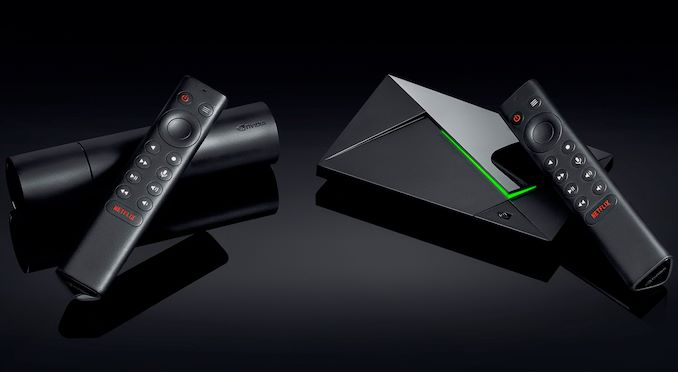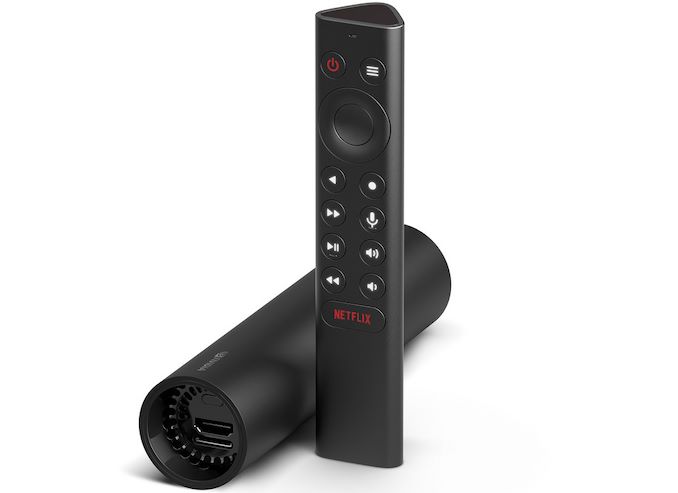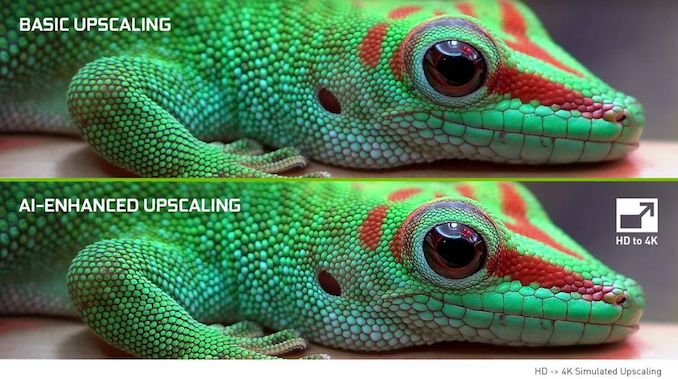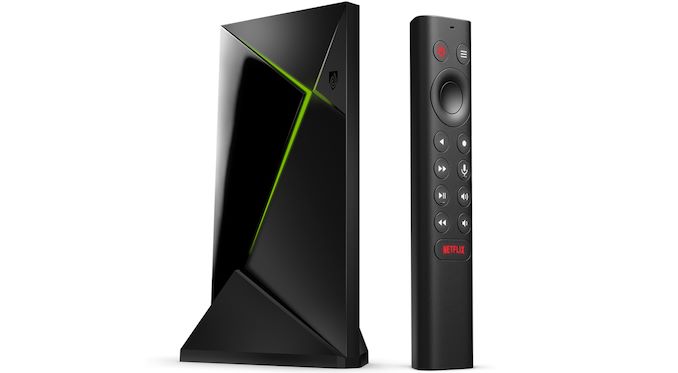NVIDIA Reveals New SHIELD TV: Tegra X1+, Dolby Vision, Dolby Atmos
by Anton Shilov on October 29, 2019 11:00 AM EST
NVIDIA has introduced new versions of its SHIELD TV set-top-boxes featuring an all-new design as well as based on an improved Tegra X1+ SoC. The new STBs support all the features its predecessors do and add support for Dolby Vision HDR, Dolby Atmos audio, as well as a new AI-powered upscale algorithm. With the launch of the new devices NVIDIA somewhat changes concept of its STBs as they no longer come with a gamepad.
The new NVIDIA SHIELD TV devices use the company’s new Tegra X1+ SoC that is said to be 25% faster when compared to the original one launched over four years ago. The chip essentially has the same feature set and Maxwell graphics, so games developed with the original SoC in mind will work with the new one without any problems. Meanwhile, since the Tegra X1+ is made using a more advanced process technology, this allows NVIDIA to offer the new SHIELD TV in a more compact form-factor. At the same time, the new SoC is paired with 2 GB of RAM (down from 3 GB) as well as 8 GB of NAND flash storage (down from 16 GB previously), which can be expanded using a microSD card. The SHIELD Pro has 3 GB of RAM as well as 16 GB of NAND storage, but no longer has a hard drive.
NVIDIA made its new SHIELD TV smaller than the predecessor in a bid to better compete against compact streaming media device, such as Google’s Chromecast/Chromecast Ultra. From connectivity standpoint, the new STB features Wi-Fi 5, Bluetooth 5.0, a GbE port, an HDMI 2.0b output with HDCP 2.2, and a microSD card slot. Meanwhile, it no longer has USB 3.0 ports, possibly to save space and simplify design. Those who need USB 3.0 should buy the SHIELD Pro with two USB Type-A ports.
| NVIDIA SHIELD STB Family | ||||||
| SHIELD TV (2019) |
SHIELD TV Pro (2019) |
SHIELD TV (2017) |
SHIELD TV Pro (2017) |
SHIELD Android TV (2015) |
||
| SoC | Tegra X1+ | Tegra X1 (4 × Cortex A57 + 4 × Cortex A53, Maxwell 2 SMM GPU) |
||||
| RAM | 2 GB | 3 GB | 3 GB LPDDR4-3200 | |||
| Storage | 8 GB NAND microSD |
16 GB NAND USB |
16 GB NAND USB |
16 GB NAND 500 GB HDD microSD USB |
16 GB NAND 500 GB HDD (Pro only) microSD USB |
|
| Display Connectivity | HDMI 2.0b with HDCP 2.2 (4Kp60, HDR) | |||||
| Dimensions | Height | 40 mm 1.57 inch |
98 mm 3.858 inch |
130 mm 5.1 inch |
||
| Width | 40mm 1.57 inch |
159 mm 6.26 inch |
210 mm 8.3 inch |
|||
| Depth | 165 mm 6.5 inch |
26 mm 1.02 inch |
25 mm 1 inch |
|||
| Weight | 137 grams | 250 grams | 654 grams | |||
| Power Adapter | integrated | ? | 40 W | |||
| I/O | Wireless | 2x2 802.11a/b/g/n/ac Bluetooth 4.1/BLE |
||||
| USB | - | 2 × USB 3.0 | 2 × USB 3.0 1 × micro-USB 2.0 |
|||
| IR | - | - | - | IR Receiver | ||
| Ethernet | Gigabit Ethernet | |||||
| Launch Product Bundle | Shield Remote | Shield Controller Shield Remote |
Shield Controller | |||
| Launch Price | $149.99 | $199.99 | $199.99 | $299.99 | Basic: $199.99 Pro: $299.99 |
|
When it comes to decoding capabilities, the new SHIELD TV can decode H.265/HEVC, VP8, VP9, H.264, MPEG1/2, H.263, MJPEG, MPEG4, and WMV9/VC1 video. Meanwhile, the STB does not support AV1 as well as VP9.2 codecs because they are not widespread at the moment. The new SHIELD TV can playback 4Kp60 HDR, 4Kp60, Full-HD 60 fps content, and can upscale 720p and 1080p content to 4Kp30 using an AI-enhanced algorithm. It is unclear whether the algorithm relies on a new hardware block that is present only inside NVIDIA’s Tegra X1+, or uses a combination of hardware and software, which means that it could be enabled on previous-generation SHIELD TV consoles too
| NVIDIA's 2019 SHIELD TV STBs | |||
| Video | |||
| 4K HDR at 60 FPS | H.265/HEVC | ||
| 4K at 60 FPS | VP8, VP9, H.264, MPEG1/2 | ||
| 1080p at 60 FPS | H.263, MJPEG, MPEG4, WMV9/VC1 | ||
| HDR | HDR10, Dolby Vision | ||
| Containers | Xvid/ DivX/ASF/AVI/MKV/MOV/M2TS/MPEG-TS/MP4/WEB-M | ||
| Audio | |||
| Audio Support | AAC, AAC+, eAAC+, MP3, WAVE, AMR, OGG Vorbis, FLAC, PCM, WMA, WMA-Pro, WMA-Lossless, Dolby Digital Plus, Dolby Atmos, Dolby TrueHD (pass-through), DTS-X (pass-through), and DTS-HD (pass-through) | ||
| High-Resolution Audio Playback | up to 24-bit/192 kHz over HDMI and USB | ||
| High-Resolution Audio Upsample | up to 24-bit/192 kHz over USB | ||
The new SHIELD TV STBs come with a redesigned SHIELD remote with improved ergonomics and more buttons. The unit has a built-in microphone for Google Assistant and Amazon Alexa; motion-activated backlit buttons; Bluetooth connectivity to connect to the player; and an IR blaster to control volume and power on TVs, soundbars or receivers.
Being based on Android TV/Android 9.0 (Pie) platform, the SHIELD TV ships with a variety of content deliver apps, including Netflix, YouTube, Amazon Prime Video, Amazon Music, Vudu, Google Play Movies & TV, Plex, Google Play Games, NVIDIA Games, and Google Games. End-users may install additional apps themselves if they need to.
Because of the simplified design and the lack of bundled gamepad, the new NVIDIA SHIELD TV media players are cheaper than their predecessors: the base model costs $149.99 (down from $199.99), whereas the Pro model is priced at $199.99 (down from $299.00).
Related Reading:
- SHIELD TV Now Supports 120 Hz Refresh, Ups Wi-Fi Bandwidth for GeForce NOW
- NVIDIA Unifies GeForce NOW Service Across PCs and SHIELD TV STBs: 200+ Games Supported
- NVIDIA Temporarily Slashes $30 Off the SHIELD TV: Now Staring at $149
- NVIDIA Releases Android 7.0 Update for 2015 SHIELD TV, Adds Amazon Video App
- NVIDIA Launches SHIELD TV: Smart Home Functionality, More 4K HDR Streaming Services
- NVIDIA SHIELD Android TV Console Adds Support for Vudu, HDR and 4Kp60 Content
Source: NVIDIA













80 Comments
View All Comments
Yojimbo - Wednesday, October 30, 2019 - link
Often times the reason for such decisions comes down to product differentiation. They want to entice people to buy the higher priced part which is probably higher margin, as well. And 8 GB covers the utility of the vast majority of their market, they are multiple upgrade paths available for those who it does not, and every dollar they can successfully shave off in their cost to manufacture is important if a company wishes to be lean and profitable. It's a cost and benefit analysis. I'm not saying they made the right decision, I have no idea, but it's a lot more nuanced than "there was 16GB in phones 10 years ago" (a completely different market at a completely different price point, no less) or "it would only cost X to add it".DigitalFreak - Tuesday, October 29, 2019 - link
I had a Shield TV hooked up to my old TV. I bought a new Sony A9G with Android TV built in, and the Shield TV has been relegated to just playing MKVs, since the Sony won't decode TrueHD or DTS-MA.metal571 - Tuesday, October 29, 2019 - link
But can it do proper 24p thoname99 - Tuesday, October 29, 2019 - link
So (serious question here, not trying to start a fight or argue a point) what is the market for a device like this?The way I see it, there's a fairly obvious market for Apple TV -- it's a way to get content on your TV using an Apple-like UI, and it plays nicely with all your other Apple stuff.
Now if you're not part of the Apple world you still want to get stuff onto your TV using a nice UI. Options seem to be
- use an HTPC
- use a Google device like the various Chromecasts
- use a Roku?
So is the idea that this is basically an Apple TV for people who are Android? Or Windows?
What's the win over Chromecast? (Or do I misunderstand Chromecast? Is it PURELY about picking up a stream from another device, not about hosting apps like Netflix or Plex?)
What's the win over say Roku (which seems to be a LOT cheaper)?
Is the point that the cheap boxes pretty much ONLY decode video, while this more expensive box does a reasonable job of playing games?
One reason I am asking all this is that for years Apple has been quietly pushing Apple TV as a box that can do more than just decode video, in particular it can also play games. And the claim is that this has never really gained traction.
Maybe Apple Arcade will change that, but I'm curious whether this sort of strategy worked for Shield. Is there a big community of gamers around Shield? And if so, what made that happen compared to, say, Apple TV?
jordanclock - Tuesday, October 29, 2019 - link
This is an Android TV device. So, it runs Android apps (many work surprisingly well with a remote and no extra changes by the dev) and acts as a Chromecast. It can act as a Plex server. It can play games locally, streaming from the cloud or streaming from your PC.My Shield acts as, essentially, my entire media center. I use it for all TV and movie watching, which includes Netflix, Hulu, HBO Now, Amazon Video, and Curiousity Stream along with pulling media from my Plex server. I also use GameStream to play my PC games on my TV, as well as playing most any Android games with controller support. It also handles emulation up through PSX/N64 quite well.
There is really nothing that fully competes with the Shield. Other standalone Android TV devices (the few that there are) don't have the full breadth of features or the performance and it has had a better track record of OS updates than really any other Android device I've ever dealt with.
name99 - Tuesday, October 29, 2019 - link
So, basically it acts like the Android version of an Apple TV? (Meaning not just the aTV functionality, but kind of "brandwise" the high-end solution, the one that you mostly trust to get things right, to provide all the functionality, and to stay up to date)?OK, thanks!
As for the technologies you list,
- mostly that's about the same sort of functionality as on an aTV.
- the one obvious missing piece is live/OTA TV. I do that by running Channels DVR on my Mac mini, and running a Channels DVR client on my aTV. I think Channels DVR is cross platform, or you can probably do something with Plex. But OTA recording is something some people care about, some don't!
- does Shield act as a hub for home devices? Home IoT is still a godawful mess (for everyone...) with every company requiring its own hub and app. But to the extent that stuff does support HomeKit, I have found it occasionally useful that I can get to this stuff when I'm outside the house because the aTV acts as a gateway from the outside internet to control (HomeKit) devices inside the house.
- how is GameStream different from any standard screencasting solution (like Airplay for Apple, or Chromecast)? I'm not a gamer, but I have occasionally used Airplay to throw video that was in a browser window onto my TV and that worked fine but of course that's not demanding of latency.
- I wonder if the emulation of old games was the real difference for gaming acceptance on Shield vs aTV? That might be an interesting business strategy, to port/rewrite a whole bunch of classic games from the Apple world (Oregon Trail and Wizardry, Snake, that Spectre tank game, Bolo, Myst, ...) to Apple Arcade to bring people in on the nostalgia ticket...
jordanclock - Tuesday, October 29, 2019 - link
Shield has support for things like HD Homerun and other OTA DVRs. Plex works great with them so you can store you stuff locally (likely to an attached USB drive) or to a network drive.There is support to use the Shield as an IoT hub using a SmartThings USB attachment.
GameStream is different because it is very low latency, quite high visual fidelity and it makes things like using a mouse/keyboard or controller on the Shield completely transparent to the game. I can launch Steam's Big Picture mode and launch a game just as easily as if I was at my PC.
Emulation is especially nice on the Shield because it is rather powerful compared to any other Android TV device and the Shield controller is, in my opinion, great.
BenSkywalker - Tuesday, October 29, 2019 - link
Apple TV is like a stripped down Shield with markedly weaker internals aimed at Apple only customers. Nintendo's Switch uses a weaker version of the SoC from the 2015 Shield. Comparing Apple arcade, Shield has GeForce now, the native Android nVidia specific titles and the ability to steam your PC games to Shield using GeForce Experience (GeForce graphics card required).Shield can also operate as a Plex server. Support for Shield TV is also better than any other Android device, the 2015 model still gets regular updates and even major version updates.
Apple's 4k TV offering was the first device they offered that wasn't laughably outclassed by Shield TV, and it still wasn't really comparable.
name99 - Tuesday, October 29, 2019 - link
That is the WRONG way you answer this sort of question.- You're throwing out a whole lot of buzzwords from the Shield ecosystem that make no sense to anyone not inside it. (GeForce now, GeForce Experience)
- I (and I expect every reader) was specifically NOT interested in an Android vs Apple wank-off. The Apple folks aren't going to buy a Shield, the Shield folks aren't going to buy an aTV. That's fscking obvious. So why waste time with the silly insults?
You COULD provide a service to us by explaining these buzz words and why they matter...
BenSkywalker - Tuesday, October 29, 2019 - link
Apple arcade was brought up, nobody explained that buzz word, and the ones I mentioned have been around a *lot* longer.Also, the only thing I mentioned that was Android based was updates, all the rest are Shield specific, not Android TV. In other words, I was directly comparing two devices, not operating systems.